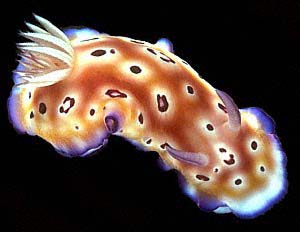
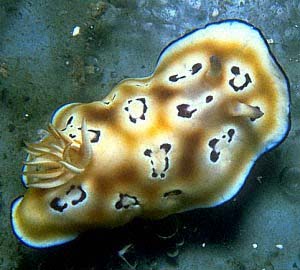
Chromodoris leopardus
Rudman, 1987
Order: NUDIBRANCHIA
Suborder: DORIDINA
Family: Chromodorididae
DISTRIBUTION
Tropical West Pacific, and reported below from NW Australia.
PHOTO
UPPER: North Stradbroke Is., Queensland. October 1979. 59mm long alive. PHOTO: John Fields.
LOWER: Heron Is., Queensland. 10m, December 1980. PHOTO: G. Avern
This is one of a group of similarly coloured species which I have called the "Risbecia tryoni colour group". Other species include Risbecia tryoni, Chromodoris kuniei and Chromodoris geminus. They all have large purple or purple-brown spots or marks, usually ringed with white, an often reticulate brownish background, and a purple border. Chromodoris geminus differs in having four colour bands around the mantle edge, an outermost white, then translucent greyish purple, then white, then yellow. The other three have a distinct purple line at the border, narrow in C. leopardus and R. tryoni, but broad in C. kuniei. The shape of the body of R. tryoni, high with a reduced mantle overlap, is typical of the genus Risbecia. The three species of Chromodoris have a wide mantle overlap. Of the three with the purple mantle edge, C. leopardus and C. kuniei can be distinguished from R. tryoni by the broad purple border, consisting of three slightly different coloured bands in C. kuniei, and by the leopard-like multiple spots, or marks, forming a hollow square, found in C. leopardus.
References:
• Rudman, W.B. (1984) The Chromodorididae (Opisthobranchia: Mollusca) of the Indo-West Pacific: a review of the genera. Zoological Journal of the Linnean Society 81: 115-273.
• Rudman, W.B. (1987) The Chromodorididae (Opisthobranchia: Mollusca) of the Indo-West Pacific: Chromodoris epicuria, C. aureopurpurea, C. annulata, C. coi and Risbecia tryoni colour groups. Zoological Journal of the Linnean Society 90: 305-407.
Rudman, W.B., 1999 (January 22) Chromodoris leopardus Rudman, 1987. [In] Sea Slug Forum. Australian Museum, Sydney. Available from http://www.seaslugforum.net/find/chroleop
Related messages
Chromodoris leopardus - feeding
April 30, 2007
From: Edward Dixon

efdixon@yahoo.com
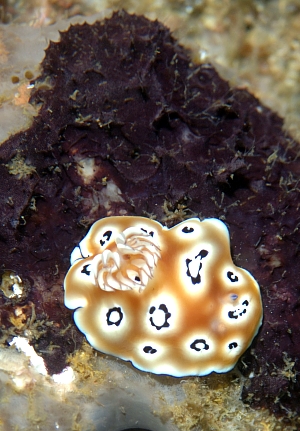
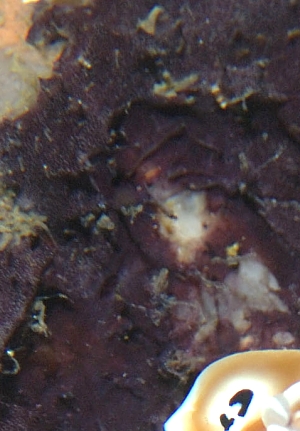
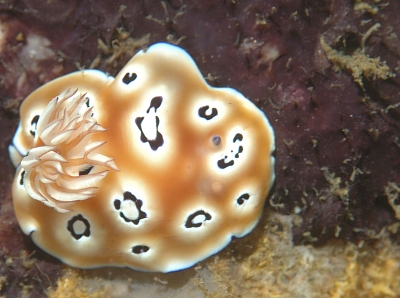
Dear Ed,
Thanks very much for these photos. I noticed one of these photos when I was scanning through some of your photosets on the web Even as I thumbnail photo I thought I recognised it as C. leopardus on the dark purple sponge Chelonaplysilla violacea and your photos confirm this. This is an interesting find as it is a species I suspected ate this sponge but until now I had no convincing evidence. [http://www.flickr.com/photos/efdixon/sets/ ].
C. leopardus is one of a group of species which have a dark purple patch covering the underside of the anterior mantle. Interestingly, all the species with this patch for which we have feeding information feed on this same dark purple sponge.
Best wishes,
Bill Rudman
Chromodoris leopardus from Indonesia
August 20, 2005
From: Marli Wakeling
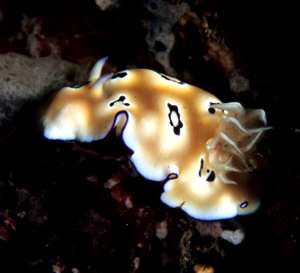
Hi Bill,
I found this Chromodoris leopardus just in front of Mimpi at Tulamben, Bali, on a rather mucky kind of dive.
Locality: Tulamben, Bali, Indonesia. Depth: 25 feet. Length: 30 mm. 24 July 2005. silt covered rubble. Photographer: Marli Wakeling
Cheers,
Marli
scubamarli@gmail.com
Wakeling, M., 2005 (Aug 20) Chromodoris leopardus from Indonesia. [Message in] Sea Slug Forum. Australian Museum, Sydney. Available from http://www.seaslugforum.net/find/14598Thanks Marli,
Bill Rudman
Chromodoris leopardus from Sipadan
June 28, 2005
From: Sergey Parinov
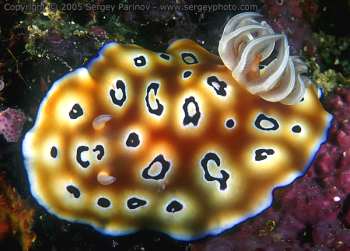
This picture of Chromodoris leopardus almost cost me missing the famous giant school of Chevron barracuda.
Locality: Sipadan Island, Malaysia. Celebes Sea. Depth: 15 m. Length: 4 cm. April 2003. Vertical reef wall. Photographer: Sergey Parinov
Sergey Parinov
webmaster@sergeyphoto.com
Sergey Parinov, 2005 (Jun 28) Chromodoris leopardus from Sipadan. [Message in] Sea Slug Forum. Australian Museum, Sydney. Available from http://www.seaslugforum.net/find/14116
Dear Sergey,
I'm glad you didn't miss the barracuda experience. I know it sounds a bit strange to be excited by a photo of an anus, but your photo shows very clearly the anal papilla surrounded by the circle of gills. I am often asked why the animal's waste products are released amongst its gills, which need clean oxygenated water. This phenomenon is best explained as an historical legacy, much like we have tail bones of no functional use. In the snail-like ancestors of opisthobranchs, the flap of specialised skin [the mantle], which produces the shell, forms a cavity, protected by the shell, which we call the mantle cavity. This cavity protects the gills and is a place into which the anus, kidney opening and reproductive openings are situated. In nudibranchs the shell and mantle cavity have been lost during evolution, but the ancient link between gills and anus has remained. Have a look at the Torsion Fact Sheet for more background information.
Best wishes,
Bill Rudman
Chromodoris leopardus & Hypselodoris bollandi
June 28, 2005
From: Sergey Parinov
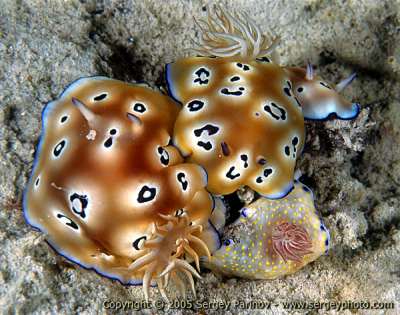
Dear Bill,
These are three Chromodoris leopardus and one Hypselodoris bollandi. I found them during night dive near Lankayan island at sandy bottom close to the jetty ~7 meters deep.
Locality: Lankayan island, north east off the coast of Sabah, Malaysia. Sulu Sea. Depth: 7 meters. Length: 3-5 cm. April 2003. sandy bottom. Photographer: Sergey Parinov
Do you know why these two species are together?
Sergey Parinov
webmaster@sergeyphoto.com
Parinov, S., 2005 (Jun 28) Chromodoris leopardus & Hypselodoris bollandi. [Message in] Sea Slug Forum. Australian Museum, Sydney. Available from http://www.seaslugforum.net/find/14137Dear Sergey,
The only reason I can think of to explain them being together, other than chance, is that they feed on the same species of sponge, which is perhaps hidden beneath them. My first move when seeing something like this would be to give the animals a gentle nudge to see if there was something interesting happening out of sight. While food sponge colonies are often larger than the nudibranchs, at times animals will be found feeding on small, recently settled, sponge colonies much smaller than themselves.
Best wishes,
Bill Rudman
Chromodoris leopardus from Malaysia
September 10, 2003
From: Asther M. Lau
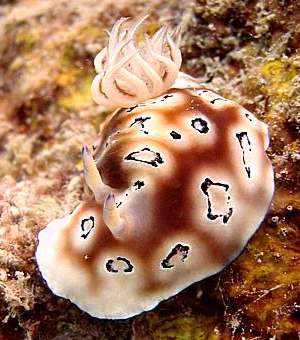
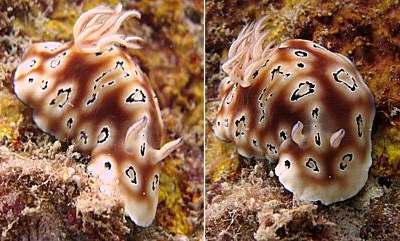
Hi Bill,
Please help identify this.
Site: Terumbu Tiga, Perhentian Is. Malaysia
Depth: 17 meter
Size: About 4cm at its current position
Date: June 14th, 2003
Thank you!
Asther M. Lau
diveworldwide@yahoo.com
Lau, A.M., 2003 (Sep 10) Chromodoris leopardus from Malaysia. [Message in] Sea Slug Forum. Australian Museum, Sydney. Available from http://www.seaslugforum.net/find/10915Dear Asther,
This is Chromodoris leopardus. It has similarities to Risbecia tryoni, the subject of your recent messages, but three obvious external differences are the wide mantle skirt in C. leopardus, the colour of the rhinophores, and the form of the purple spots, which in C. leopardus usually form a quadrangular ring of four spots, much like in a leopard.
Best wishes
Bill Rudman
Chromodoris leopardus from Indonesia
December 2, 2002
From: Sabine Noack

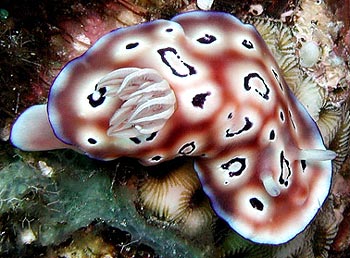
Dear Bill,
Here are 2 pictures of Chromodoris leopardus in different colors.
Upper: (with the small passenger)
Size: ~5cm,
Depth: ~8m
Dive Site: Crinoid Canyon, Nusa Kode, Indonesia. October 2002, daytime
Lower:
Size: ~4cm,
Depth: ~5m
Dive Site: Pasir Putik, Moyo, Indonesia. October 2002, daytime
Regards,
Sabine
dive@snoack.de
Noack, S., 2002 (Dec 2) Chromodoris leopardus from Indonesia. [Message in] Sea Slug Forum. Australian Museum, Sydney. Available from http://www.seaslugforum.net/find/8495Thanks Sabine,
Its very useful to have examples showing the variations in the brown background colour. It is interesting to see how similar they are to the two photos from eastern Australia on the species Fact Sheet
Best wishes,
Bill Rudman
Chromodoris leopardus from Bali
February 18, 2002
From: Stuart Hutchison
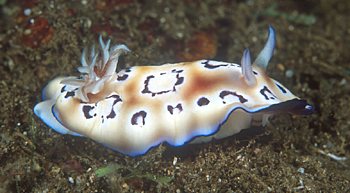
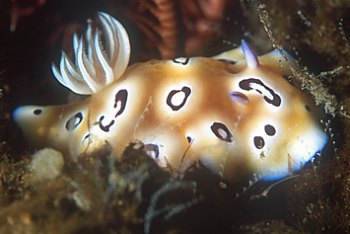
Bill,
Here are two Chromodoris leopardus found at 20m, one on a small algae covered rock and the other on a steel wreck in Bali, Indonesia. No obvious food source. Lengths were approx 50mm. 25 October 2001.
Stuart Hutchison
stuart@stuarthutchison.com.au
Hutchison, S., 2002 (Feb 18) Chromodoris leopardus from Bali. [Message in] Sea Slug Forum. Australian Museum, Sydney. Available from http://www.seaslugforum.net/find/6257Thanks Stuart,
Bill Rudman
Chromodoris leopardus from the Philippines
May 30, 2001
From: Mary Jane Adams
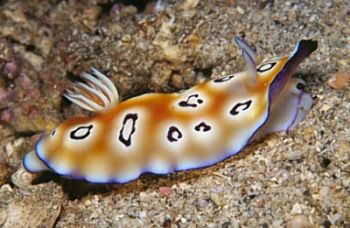
Hi Bill,
Here is a Chromodoris leopardus I found in the Philippines. I took several shots of it and each one tells a different story. The upper one shows it lifting its mantle to reveal the purple color beneath the anterior end. The lower right picture shows a damaged area on the left where I imagine a fish has had a bite. The lower left shot, taken at an oblique angle, shows that the tips of the rhinophores are bifid.
Depth: about 10 meters, Length: 25 mm,
Divesite: Koala, Batangas, Philippines, May 10, 2001
What a gorgeous animal!
Best regards,
Mary Jane
divepng@yahoo.com
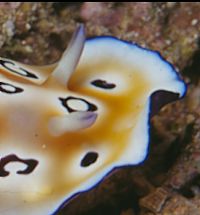
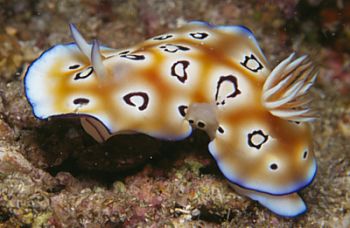
Thanks Mary Jane,
Bill Rudman.
Chromodoris leopardus from Solomon Ids
May 23, 2001
From: Bruce Potter
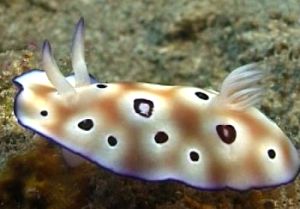

Bill,
Last sunday I found a small Chromodoris leopardus at about 8 meters on a rubble site just on the outskirts of Honiara, Solomon Islands. It was about 2cm long [Upper photo].
I had previously found a much larger one near the same place a couple of years ago. It was about 40mm long. [Lower photo].
Regards
Bruce Potter
bruce.potter@adventist.org.sb
Potter, B., 2001 (May 23) Chromodoris leopardus from Solomon Ids. [Message in] Sea Slug Forum. Australian Museum, Sydney. Available from http://www.seaslugforum.net/find/4357Thanks Bruce,
Sometimes small animals like you upper photo are not that easy to distinguish externally from Risbecia tryoni. Sometimes you can see the mantle glands, which in C. leopardus form a diffuse submarginal band all around the mantle while in R. tryoni the glands are small white spheres right at the mantle edge, small along the sides and larger posteriorly.
Best wishes,
Bill Rudman
Chromodoris leopardus from NW Australia
May 5, 1999
From: Clay Bryce
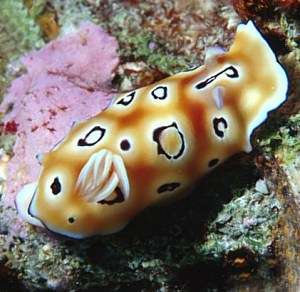
Dear Bill,
Here is C. leopardus from Scott Reef - WAM154-94., perhaps a new record?, from the Kimberley region, Northwestern Australia.
Clay Bryce,
W.A. Museum
Perth.
brycec@museum.wa.gov.au
Bryce, C., 1999 (May 5) Chromodoris leopardus from NW Australia. [Message in] Sea Slug Forum. Australian Museum, Sydney. Available from http://www.seaslugforum.net/find/833Dear Clay,
Definitely C. leopardus. Thanks for the record.
Bill Rudman.
Rudman, W.B., 1999 (May 5). Comment on Chromodoris leopardus from NW Australia by Clay Bryce. [Message in] Sea Slug Forum. Australian Museum, Sydney. Available from http://www.seaslugforum.net/find/833